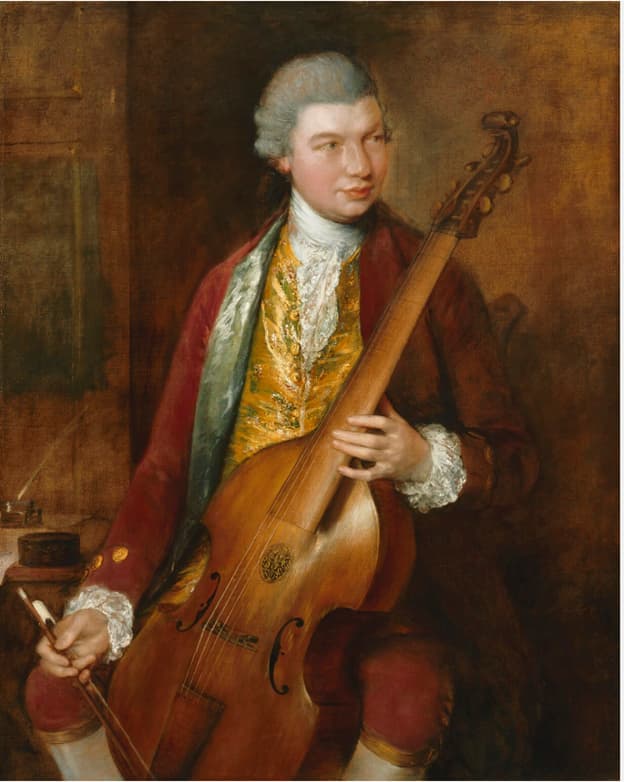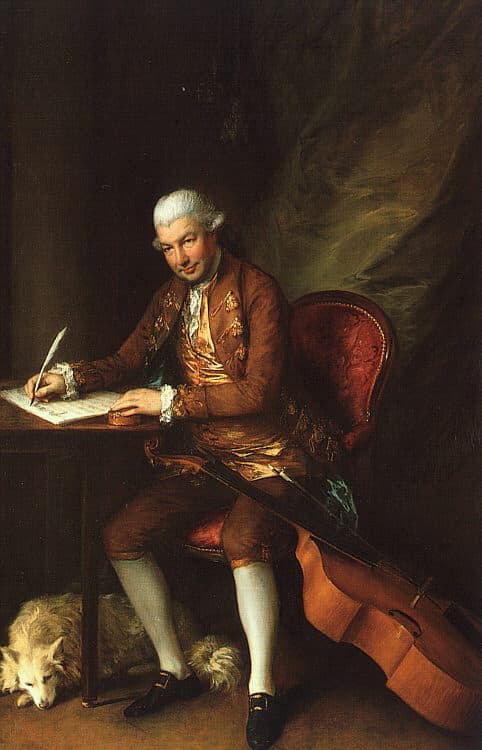English musician and historian Charles Burney, in his History of Music, vol. 2 (1782), credited three people with being the style leaders of the day: Felice Giardini, the director of the Italian opera theatre; J.C. Bach (London Bach), and Carl Friedrich Abel, the last great virtuoso of the viola da gamba. The three were considered the avant-garde of the sensitive Neapolitan style in London. Bach and Abel together became a powerful force as co-promoters of concerts in London. Abel also supplied a number of orchestral works and was also a soloist.
Carl Friedrich Abel was born in Köthen, Germany, in December 1723, the same city where J.S. Bach had served as Hofkapellmeister until May 1723. Bach left to become the Thomaskantor in Leipzig, and his job in Köthen was taken over by C.F.’s father, Carl Ferdinand. Carl Friedrich studied with his father, who was also a gambist and may also have taken lessons from J.S. Bach in Leipzig. By the 1740s, Carl Friedrich was a member of the Dresden Court Orchestra under the direction of Johann Adolph Hasse. Hasse was known for his Italian operas, done in the latest Neapolitan style. The Neapolitan emphasis on melody, versus the contrapuntal style of Germany, caught Carl Friedrich’s ear, and even his first symphonies from the 1750s show this influence.

Thomas Gainsborough: C.F. Abel, 1765 (National Portrait Gallery)
Symphonies at this time were still not quite an independent instrumental genre, and many still carried the title ‘overture’ and, melodically, seemed as though they could be used to open an opera (it was not yet common that opera overtures were made up of melodies from the opera to come).
When Dresden was occupied by the Prussians, Abel left the court orchestra. He went to Leipzig then Mannheim, where Johann Stamitz and Christian Cannabich were creating innovations in orchestration and symphonic structure that would spread all over Europe. He visited the Goethe family in Frankfurt, where the poet’s father welcomed him. By 1759, he was in London, which was challenging Paris and Vienna for the title of ‘most important music metropolis’.
His first concert on 5 April 1759 was the day before the last public appearance of Handel, who performed in Messiah playing the organ part. In the mid-1760s, he and J.C. Bach created the ‘Bach-Abel Concerts,’ where tickets to their weekly concerts were sold by subscription. The concert series lasted for two decades.
Abel didn’t remain solely in London, but in the late 1770s travelled back to Germany. His last symphonies were presented in Berlin to the Prussian heir to the throne, Frederick William. Frederick William was passionate about the cellos but had started as a viola da gamba player in his youth.

Thomas Gainsborough: C.F. Abel, 1777 (Huntington Library)
The Symphony in C major, like all of Abel’s final symphonies, only has 3 movements, but, with their full orchestral sound, were ideal openers for the London concert series. Abel varies the scorings so that there’s a variety in the sound and makes the two violin parts the main melody bearers. The wind instruments, 2 oboes, and 2 horns are used to frame movements and add rhythmic interest.
In his Symphony in D major, WKO 41, we see some writing that foreshadows the innovations Haydn will be bringing to London in a decade. This symphony adds flutes to the normal orchestration, and this brings a new brightness to the sound. Abel’s innovation comes after the opening string unison where he starts a development section that is ‘modulation-rich’, something that Haydn would bring in his London symphonies 10 years later.
Carl Friedrich Abel: Symphony in D Major, WKO 41 – I. Allegro maestoso (Main Baroque Orchestra, Frankfurt; Frankfurt Baroque Orchestra; Martin Jopp, cond.)
The second movement, a pensive Andante, is augmented by long-held notes in the flutes above the violin lines.
Carl Friedrich Abel: Symphony in D Major, WKO 41 – II. Andante (Main Baroque Orchestra, Frankfurt; Frankfurt Baroque Orchestra; Martin Jopp, cond.)
The final movement offers the contrast of a light-hearted opening followed by a melancholic Trio section where the oboes make chains of thirds above a dancing violin line.
Carl Friedrich Abel: Symphony in D Major, WKO 41 – III. Tempo di Menuetto (Main Baroque Orchestra, Frankfurt; Frankfurt Baroque Orchestra; Martin Jopp, cond.)
It’s often difficult to see the innovations of one decade when they become the normal of the following decade, but in Abel, who had his musical education in some of the most forward-looking courts and cities in Europe, we have a composer who was truly ahead of his time.
For more of the best in classical music, sign up for our E-Newsletter
